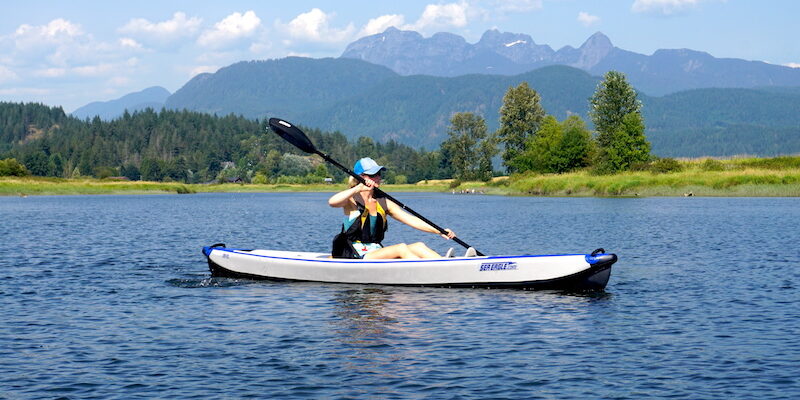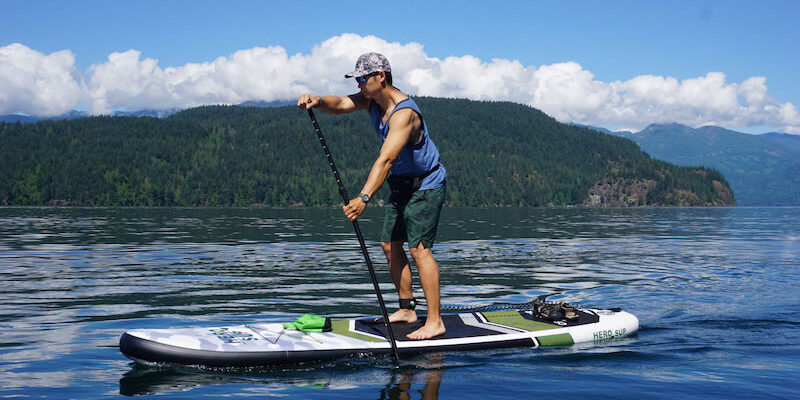Stand-up paddle boards are all the rage. In fact you may have noticed they are suddenly everywhere you look.
They are a cross between surfing and kayaking and one of the most fantastic workouts you could ever have.
Stand-up paddling is a sport that any person of any age can enjoy and it is excellent for working on your balance and core strength.
You do not necessarily need a SUP to take part, many have been doing this in their inflatable kayaks as well as in hard-shell kayaks for years.
I was first introduced to this cool new sport in Hawaii where it is common to see a wide range of people from seniors to young children calmly paddling along the shorelines and through the rivers with their stand-up paddle boards.
The more adventurous types are tackling the waves and hitting the whitewater rapids.
After a friend of mine bought the Sea Eagle Inflatable SUP and I borrowed it a few times I was hooked.
Although it has a slight learning curve, once you gain your balance and learn how to paddle properly it is truly a lot of fun.
The more I researched stand-up paddle boards the more I realized the versatility of them and that it was really not that new after all.
Paddlers have been standing in kayaks and other crafts for years.
Of course the first place my mind went was to converting my inflatable kayak into a SUP.
Then with a little more research I realized that my ingenious idea was old news…
Meet Jeff Snyder
Jeff Snyder (pictured above) was stand-up paddle boarding before there ever was stand-up paddle boards.
He invented striding-standing in an inflatable kayak in 1993 after watching a Mayan woman paddle a dugout canoe standing up.
After injuring his back badly on a 40-foot waterfall on the Aqua Azul in Mexico he had the AIRE Force XL inflatable kayak customized with cargo loops on each side of the kayak and developed the striding technique.
In essence this technique allowed him to absorb the river with his legs instead of with his back by standing with one foot in front of the other about 20 inches apart.
For leverage he wears shin guards and presses his shins against the thwarts. His brother Jim now makes SUP paddles which are very popular.
Jeff wasn’t the only kayaker to suddenly realize the benefits of standing while paddling.
Many others have either accidentally or purposely converted their kayaks to stand-up paddle boards and it is easily doable with an inflatable kayak.
The SUP Movement
If you want to participate in the SUP movement and see what all the rave is about you do not necessarily need to go purchase a SUP although there are some excellent inflatable options available.
All you need to practice your striding skills is an inflatable kayak with a rigid floor.
Stand-up paddle boards use a unique one-bladed paddle with a handle at the other end.
Although you can use this with your kayak if you like it is not absolutely necessary.
You can also use a regular kayak paddle (the longer the better). The technique is a little different with a regular kayak paddle but equally as enjoyable.
You do not necessarily need to outfit your inflatable kayak with any special accessories like Jeff did.
For regular flat water, or shoreline paddling all you need is your kayak and your paddle.
For whitewater paddling you may want to consider the cargo loops for the added stability.
Inflatable Kayaks that Work Best for SUP
A good stand-up paddle board of course will always offer you the best ride as it was designed specifically for stand-up paddling where a kayak was not.
However if you want to use your inflatable kayak and enjoy the best of both worlds the below two models are ideal…
For whitewater – The AIRE Force offers the perfect balance of a rigid floor and whitewater manoeuvrability.
For flatwater and along shorelines – The Sea Eagle FastTrack is ideal with its super rigid floor, good tracking and seats that can be moved around or taken out.
If you already have a different inflatable kayak, then test it out and if you find that the floor is not hard enough you can always add a floor board for extra rigidity.
Recommendations
Start off in very flat water until you feel comfortable with your balance. Then work your way into the waves and stay where you feel safe.
I can tell you that it takes a lot of practice to be able to stand-up paddle in waves.
It is the ultimate test for your balance and stability and you can expect to get wet… you will likely fall in the water a lot!


Leave a Reply Cancel reply